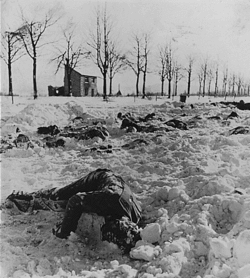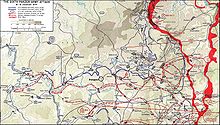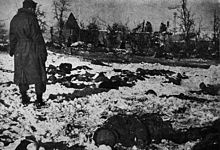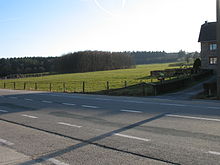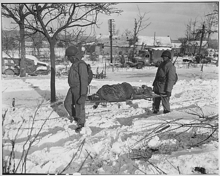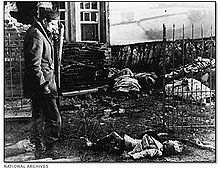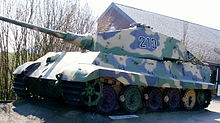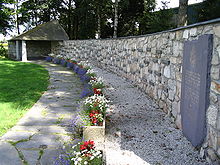- Malmedy massacre
-
Malmedy Massacre Location near Malmedy, Belgium Date December 17, 1944 Attack type Mass murder Death(s) 84 American POWs Perpetrator(s) 1st SS Panzer Division Prelude
Battle of Vianden – Battle of KesternichInitial German assault
Losheim Gap – Battle of Clervaux – Lanzareth Ridge – Malmedy massacreAllied defense and counteroffensive
Elsenborn Ridge – St. Vith – BastogneGerman counterattack
Bodenplatte – NordwindBackground
German forces – Order of battleThe Malmedy massacre was a war crime in which 84 American prisoners of war were murdered by their German captors during World War II. The massacre was committed on December 17, 1944, by members of Kampfgruppe Peiper (part of the 1st SS Panzer Division), a German combat unit, during the Battle of the Bulge.
The massacre, as well as others committed by the same unit on the same day and following days, was the subject of the Malmedy massacre trial, part of the Dachau Trials of 1946. The trials were the focus of some controversy.
Contents
Context
Hitler's plans for the Battle of the Bulge gave the main goal (breaking through Allied lines) to the 6th SS Panzer Army, commanded by General Sepp Dietrich. He was to break the Allied front between Monschau and Losheimergraben, cross the Meuse River, and then capture Antwerp.[1][2]:5 Kampfgruppe Peiper, named after and under the command of SS-Standartenführer Joachim Peiper, was composed of armoured and motorized elements and was the spearhead of the left wing of the 6th SS Panzer Army. Once the infantry had breached the American lines, Peiper's role was to advance via Ligneuville, Stavelot, Trois-Ponts, and Werbomont and seize and secure the Meuse bridges around Huy.[1]:260+[2][3]
The best roads were reserved for the bulk of the 1st SS Panzer Division Leibstandarte SS Adolf Hitler. Peiper was to use secondary roads, but these proved unsuitable for heavy armored vehicles, especially the Tiger II tanks attached to the Kampfgruppe.[1][2][3]
The success of the operation depended on the swift capture of the bridges over the Meuse. This required a rapid advance through U.S. positions, circumventing any points of resistance whenever possible. Another factor Peiper had to consider was the shortage of gasoline: the fuel resources of the Reich had been greatly reduced since the fall of Romania.
Hitler ordered the battle to be carried out with a brutality more common on the Eastern Front, in order to frighten the enemy.[2] Sepp Dietrich confirmed this during the trial for the massacre.[4] According to some sources, during the briefings before the operation, Peiper stated that no quarter was to be granted, no prisoners taken, and no pity shown towards Belgian civilians.[4]
Peiper's breakout and first massacres
From the very beginning, German military operations on the northern front were troubled by unexpectedly obstinate resistance from American troops. Peiper had hoped to exploit an opening as early as the morning of December 16, the offensive's first day, but he had been delayed by massive traffic jams behind the front, with the infantry which was to breach the U.S. lines waiting for him to arrive.[1][2] At daybreak on December 17, after moving his Kampfgruppe into the front line, Peiper broke out toward Honsfeld,[5] where elements of his force would kill several dozen American POWs.[1][2][6]
After capturing Honsfeld, Peiper left his assigned route for several kilometers to seize a small gasoline depot in Büllingen, where a massacre of American prisoners would later be reported.[1][2][6] At this point, Peiper was in the Americans' rear. Apparently unknown to him, had he advanced north from Büllingen towards Elsenborn, he could have flanked and trapped the 2nd and the 99th Infantry Divisions with possibly a vastly different outcome. However, he followed orders to stick to his Rollbahn west towards the Meuse River and captured Ligneuville, passing by Mödersheid, Schoppen, Ondenval, and Thirimont.[1]
The terrain and poor quality of the roads made his move difficult. Eventually, at the exit of the small village of Thirimont, the spearhead was unable to take the direct road toward Ligneuville. Peiper again deviated from his planned route. Rather than turn left, the spearhead veered right and advanced towards the crossroads of Baugnez, which is equidistant from Malmedy, Ligneuville, and Waimes.[1][2]
Massacre at Baugnez
Between noon and 1 p.m., the German spearhead approached the crossroads. An American convoy of about thirty vehicles, mainly elements of the American 285th Field Artillery Observation Battalion (FAOB), was negotiating the crossroads and turning right toward Ligneuville, in order to reach St. Vith, where it had been ordered to join the 7th Armored Division, to reinforce the city's defense.[2][5] The spearhead of Peiper’s group spotted the American convoy and opened fire, immobilizing the first and last vehicles of the column and forcing it to halt.[5] Armed with only rifles and other small arms, the Americans surrendered to the Nazi tank force.[1][2]
While the German column led by Peiper continued on the road toward Ligneuville, the American prisoners were taken to a field, joined with others captured by the SS earlier in the day. Most of the testimonies provided by the survivors state that about 120 men were gathered in the field. For reasons that remain unclear today, the SS troops suddenly fired on their prisoners with machine guns.[1][2] Several SS prisoners later testified that a few of the prisoners had tried to escape. Others claimed that a few of the prisoners had recovered their previously discarded weapons and fired on the German troops as they continued their progress toward Ligneuville.[5][7] Of the 88 bodies recovered a month later, most showed wounds to the head, seemingly much more consistent with a deliberate massacre than with self-defense or even to prevent escape.
As soon as the SS machine gunners opened fire, the American POWs panicked. Some tried to flee, but most were shot where they stood. A few sought shelter in a café at the crossroads. The SS soldiers set fire to the building, and shot all who tried to escape the flames.[2] Some in the field had dropped to the ground and pretended to be dead when the shooting began.[2] However, SS troops walked among the bodies and shot any who appeared to be alive.[2][5]
Later, a few survivors emerged from hiding and returned through the lines to nearby Malmedy, where American troops held the town. Eventually, 43 survivors found refuge, some with the help of Belgian civilians.[8] Testimony from the survivors was taken hours after the massacre. All the accounts were similar and corroborated each others, though the men had no opportunity to discuss the events.[5] An account of one survivor is recorded in Medicine Under Canvas, on page 141 of the second edition, which also offers details of 77th Evacuation Hospital's role in notifying Army Intelligence and their questioning of the wounded man.
The first survivors of the massacre were found by a patrol from the 291st Combat Engineer Battalion at about 2:30 p.m. the same day. The inspector general of the First Army learned of the shootings some three or four hours later. By late evening of the 17th, rumors that the enemy was killing prisoners had reached the forward American divisions.[1] One U.S. unit promptly issued orders that "No SS troops or paratroopers will be taken prisoner but will be shot on sight."[1]:261-264 There are claims that some of the American forces killed German prisoners in retaliation—e.g. in the Chenogne massacre, on January 1, 1945.
Because the Baugnez crossroads had been in no-man's-land until the Allied counter-offensive, it was not until January 14, 1945, that U.S. forces reached the massacre site and conducted an investigation. The frozen, snow-covered bodies were photographed where they lay, then removed from the scene for identification and detailed post mortem examinations. The aim was gathering evidence to be used as part of the prosecution of the apparent war crime.[9] Seventy-two bodies were found in the field on January 14 and 15, 1945. Twelve more, lying farther from the pasture, were found between February 7 and April 15, 1945.[7]
The autopsies revealed that at least twenty of the victims had suffered fatal gunshot wounds to the head, inflicted at very close range.[9] These were in addition to wounds made by automatic weapons. Another 20 showed evidence of small-calibre gunshot wounds to the head without powder-burn residue;[9] 10 had fatal crushing or blunt-trauma injuries, most likely from rifle butts.[9] Some bodies showed only one wound, in the temple or behind the ear.[10] Most of the bodies were found in a very small area, suggesting the victims had been gathered together just before they were killed.[8]iii[›]
Peiper moves on
The opening forced through the American lines by Kampfgruppe Peiper was marked by other murders of prisoners of war, and later of Belgian civilians. Members of his unit killed at least eight other American prisoners in Ligneuville.[11]
New massacres of POWs were reported in Stavelot, Cheneux, La Gleize, and Stoumont, on December 18, 19, and 20.[6] Finally, on December 19, 1944, between Stavelot and Trois-Ponts, German forces tried to regain control of the bridge over the Ambleve river in Stavelot, which was crucial for receiving reinforcements, fuel, and ammunition. Peiper’s men murdered about 100 Belgian civilians.[2][6][12][13]
American Army engineers blocked Peiper's advance in the narrow Amblève River valley by blowing up the bridges. Additional U.S. reinforcements surrounded the Kampfgruppe in Stoumont and la Gleize.[2] Peiper and 800 of his men eventually escaped this encirclement by marching through the nearby woods and abandoning their heavy equipment, including several Tiger II tanks.[1][2]:376ff If he had by-passed the Amblève bridges, Peiper could have gained higher ground and access to practicable roads to the Meuse.[citation needed]
On December 21, during the battle around Gleize, the men of Kampfgruppe Peiper captured an American officer, Major Harold D. McCown, who was leading one of the battalions of the 119th Infantry Regiment.[1]:365ff Having heard about the Malmedy massacre, McCown personally asked Peiper about his fate and that of his men. McCown testified that Peiper told him neither he nor his men were at any risk and that he (Peiper) was not accustomed to killing his prisoners.[2] McCown noted that neither he nor his men were threatened in any manner, and he testified in Peiper's defense during the 1946 trial in Dachau.
Once re-equipped, Kampfgruppe Peiper rejoined the battle, and other killings of POWs were reported on December 31, 1944, in Lutrebois, and between January 10 and 13, 1945, in Petit Thier.[6] The precise number of prisoners of war and civilians massacred attributable to Kampfgruppe Peiper is still not clear. According to certain sources, 538 to 749 POWs had been the victims of war crimes perpetrated by Peiper's men. These figures are, however, not corroborated by the report of the United States Senate subcommittee that later inquired into the subsequent trial; according to the Committee, the number of dead would be 362 prisoners of war and 111 civilians.[14] According to this report, the count of POWs or civilians killed at different places is as follows:
Place Prisoners of war Civilians Honsfeld 19 Büllingen 59 1 Baugnez 86 Ligneuville 58 Stavelot 8 93 Cheneux 31 La Gleize 45 Stoumont 44 1 Wanne 5 Trois-Ponts 11 10 Lutrebois 1 Petit Thier 1 Total 362 111 Aftermath and trial
Main article: Malmedy massacre trialOn January 13, 1945, American forces recaptured the site where the killings occurred. The cold had preserved the scene well. The bodies were recovered on January 14 and January 15, 1945. The memorial at Baugnez bears the names of the murdered soldiers.
The size of the massacre, which apparently is the only one perpetrated on such a scale against American troops in Europe during World War II, caused an uproar at the time. However, the number of victims was quite low, compared to other German atrocities.
In addition to the effect the event had on American combatants in Europe, it seems that news of the massacre also greatly affected the United States. This explains why the alleged culprits were deferred to the Dachau Trials, which were held in May and June 1946, after the war.[15]
In what came to be called the "Malmedy massacre trial", which concerned all of the war crimes attributed to Kampfgruppe Peiper for the battle of the Bulge, the highest-ranking defendant was General Sepp Dietrich, commander of the 6th SS Panzer Army, to which Peiper’s unit belonged. Joachim Peiper and his principal subordinates were defendants.[15] The Tribunal tried more than 70 persons and pronounced 43 death sentences (none of which were carried out) and 22 life sentences. Eight other men were sentenced to shorter prison sentences.[15]
After the verdict, the way in which the court had functioned was disputed, first in Germany (by former Nazi officials who had regained some power due to anti-Communist positions with the occupation forces), then later in the United States (by Congressmen from heavily German-American areas of the Midwest). The case was appealed to the Supreme Court of the United States, which made no decision. The case then came under the scrutiny of a sub-Committee of the Senate of the United States.[14] A young Senator from Wisconsin, Joseph McCarthy, used it as an opportunity to raise his political profile.[16] He stated that the Court had not tried the defendants fairly.[2][16]:24
This drew attention to the trial and the judicial irregularities that had occurred during the interrogations that preceded the trial. But, before the United States Senate took an interest in this case, most of the death sentences had been commuted, because of a revision of the trial carried out by the U.S. Army.[15] The other life sentences were commuted within the next few years. All the convicted war criminals were released during the 1950s, the last one to leave prison being Peiper in December 1956. There was a schism within the American Legion and Veterans of Foreign Wars because World War II veterans who were members protested McCarthy's defense of the convicted.[citation needed] The leadership consisting of the earlier World War I veterans was reluctant to criticize him, because of his anti-communist stance. Critics of the post-war trials of Japanese military personnel have cited the release of these war criminals as an example of the racism that characterized the difference in treatment. Japanese military personnel who were convicted of killing prisoners as a matter of policy were executed per international law and custom.[citation needed]
The turmoil that followed the Malmedy trials and the early release of the condemned is often used by some people as an example of biased post-war justice applied at the discretion of the victor.[17]
A distinct lawsuit about the war crimes committed against civilians in Stavelot was tried on July 6, 1948, in front of a Belgian military court in Liege, Belgium. The defendants were 10 members of Kampfgruppe Peiper; American troops had captured them on December 22, 1944, near the spot where one of the massacres of civilians in Stavelot had occurred. One man was discharged; the others were found guilty. Most of the convicts were sentenced to 10 years' imprisonment; two officers were sentenced to 12 and 15 years.
Death of Peiper
Peiper lived in France following his release from jail. In 1974 he was identified by a former Communist resistance member of the region who issued a report for the French Communist Party.[citation needed] In 1976 a Communist historian, investigating the STASI archives, found the Peiper file. On 21 June tracts denouncing his presence were distributed in Traves. A day later, an article in the Communist publication L'Humanité revealed Peiper's presence in Traves and he became the subject of death threats.[citation needed]
Upon the death threats Peiper sent his family back to Germany. He himself stayed in Traves. During the night from 13 July to 14 July 1976 a gunfight took place at Peiper's house, in which Peiper himself shot several times. His house was set on fire. Peiper's charred corpse was later found in the ruins with a bullet in the chest. The perpetrators were never identified, but were suspected to be former French Resistance members or Communists. Peiper had just started writing a book about Malmedy and what followed.[citation needed]
Retaliation against German prisoners
Knowledge of the massacre "led to considerable retaliation against German prisoners of war during and after that battle."[18] Few Waffen-SS soldiers came to be taken prisoner by units such as the 3rd Armored Division.[18] An example of the aftermath of the massacre is the written order from the HQ of the 328th US Army Infantry Regiment, dated December 21, 1944: "No SS troops or paratroopers will be taken prisoner but will be shot on sight." ii[›][18] A possible example of a related large massacre against Germans is the Chenogne massacre. At the Saar river the 90th Infantry Division "murdered Waffen-SS prisoners in such a systematic manner late in December 1944 that headquarters had to issue express orders to take Waffen-SS soldiers alive so as to be able to obtain information from them."[19]
In popular culture
The massacre has been dramatized in three films — Judgement at Nuremberg, where the character played by Marlene Dietrich is a widow whose fictional German general was tried and put to death for the massacre, the Battle of the Bulge (1965) and Saints and Soldiers (2004). It was also alluded to in Hart's War (2002), where the eponymous hero discovers the bodies of the victims.[citation needed]
United States television commentator Bill O'Reilly mistakenly referred, in October 2005 and May 2006, to the "Malmedy" massacre as being committed by US instead of German troops. He later explained the error as a result of his being caught up in the "heat of the debate", and stated that he was in fact intending to bring up incidents when, "after Malmedy, some German captives were executed by American troops."[20] O'Reilly recently repeated the mistake on his May 31, 2011 show. Both times he was interviewing retired General Wesley Clark.
See also
- List of massacres in Belgium
Notes
^ i: In Cole's history of World War II, footnote 5 on page 264 reads, Thus Fragmentary Order 27. issued by Headquarters, 328th Infantry, on 21 December for the attack scheduled the following day says: "No SS troops or paratroopers will be taken prisoner but will be shot on sight."[1]
^ ii: This article includes a diagram showing where the bodies were discovered.[8]
References
- ^ a b c d e f g h i j k l m n o Cole, Hugh M. (1965). "Chapter V: The Sixth Panzer Army Attack". The Ardennes. United States Army in World War II, The European Theater of Operations. Washington, D.C.: Office of the Chief of Military History. http://www.history.army.mil/books/wwii/7-8/7-8_5.htm.
- ^ a b c d e f g h i j k l m n o p q r s MacDonald, Charles (1984). A Time For Trumpets: The Untold Story of the Battle of the Bulge. Bantam Books. ISBN 0-553-34226-6.
- ^ a b Émile Engels, ed (1994) (in French). Ardennes 1944-1945, Guide du champ de bataille. Racine, Bruxelles.
- ^ a b Gallagher, Richard (1964). Malmedy Massacre. Paperback Library. pp. 110–111.
- ^ a b c d e f Reynolds, Michael (2003). Massacre At Malmédy During the Battle of the Bulge. World War II Magazine. http://www.historynet.com/magazines/world_war_2/3030591.html?page=1&c=y.
- ^ a b c d e Review and Recommendation of the Deputy Judge Advocate for War Crimes. 20 October 1947. pp. 4–22. http://137.248.11.66/attachments?lang=de&barcode=06-024.
- ^ a b Wholesale Slaughter at Baugnez-lez-Malmedy, Willy D. Alenus
- ^ a b c Glass, Lt Col Scott T. (1998-11-22). "Mortuary Affairs Operations at Malmedy". Centre de Recherches et d'Informations sur la Bataille des Ardennes. Archived from the original on 2007-09-27. http://web.archive.org/web/20070927080809/http://www.criba.be/index.php?option=com_content&task=view&id=64&Itemid=4. Retrieved 2007-03-22.
- ^ a b c d Glass, MAJ Scott T.. "Mortuary Affairs Operations At Malmedy—Lessons Learned From A Historic Tragedy". http://permanent.access.gpo.gov/lps1786/malmedy.html.
- ^ Roger Martin, L'Affaire Peiper, Dagorno, 1994, p. 76
- ^ Toland, John (December 1959). The Brave Innkeeper of "The Bulge". Coronet Magazine. http://www.criba.be/index.php?option=com_content&task=view&id=278&Itemid=4.
- ^ Kent, Capt John E.. "Stavelot, Belgium, 17 to 22 December 44". Centre de Recherches et d'Informations sur la Bataille des Ardennes. http://www.criba.be/index.php?option=com_content&task=view&id=269&Itemid=4.
- ^ Lebeau, Guy. "Sad souvenirs or life of the people of Stavelot during the winter of 1944-1945". Centre de Recherches et d'Informations sur la Bataille des Ardennes. http://www.criba.be/index.php?option=com_content&task=view&id=180&Itemid=4.
- ^ a b Malmedy massacre Investigation–Report of the Subcommittee of Committee on Armed Services. United States Senate Eighty-first Congress, first session, pursuant to S. res. 42, Investigation of action of Army with Respect to Trial of Persons Responsible for the Massacre of American Soldiers, Battle of the Bulge, near Malmedy, Belgium, December 1944. 13 October 1949.
- ^ a b c d Review and recommendation of the deputy judge advocate for war crimes, 20 October 1947 - [1]
- ^ a b Griffith, Robert (1987). The Politics of Fear: Joseph R. McCarthy and the Senate. University of Massachusetts Press. p. 22.
- ^ Bardèche, Maurice (1950). "Nuremberg II ou les Faux monnayeurs" (in French). Editions Les Sept Couleurs. p. 70 ff.
- ^ a b c Bradley A. Thayer, "Darwin and international relations" p.186
- ^ Peter Schrijvers, "The Crash of Ruin: American Combat Soldiers in Europe During World War II" p.79,80
- ^ http://www.youtube.com/watch?v=O2KU02lsfH8&feature=related
External links
- Mortuary Affairs Operations At Malmedy – Lessons Learned From A Historic Tragedy, by Major Scott T. Glass. Quartermaster Professional Bulletin, Autumn 1997
- Battle of the Bulge on the Web, Malmedy Massacre resources
- Massacre at Malmédy During the Battle of the Bulge (reprint of an article in World War II [2003] by M. Reynolds)
- Gettysburg Daily article on 65th anniversary of the Malmedy Massacre.
Coordinates: 50°24′14″N 6°3′58.30″E / 50.40389°N 6.066194°E
Categories:- History of Belgium
- Massacres in Belgium
- Nazi war crimes
- World War II prisoners of war massacres
- Nazi SS
- Battle of the Bulge
Wikimedia Foundation. 2010.

